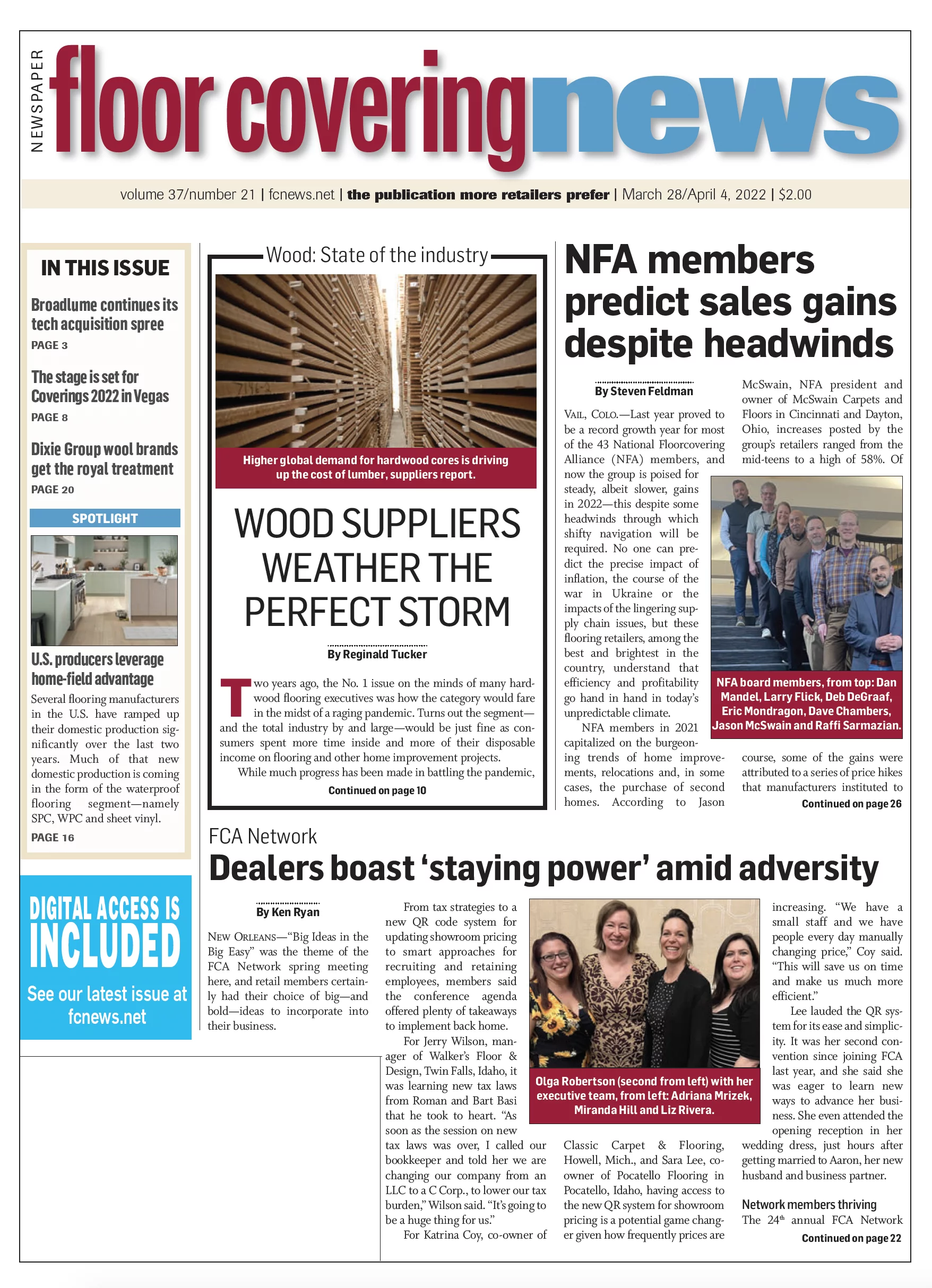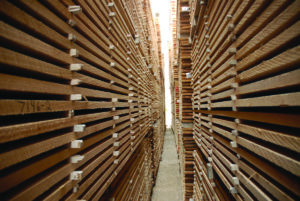
By Reginald Tucker—Two years ago, the No. 1 issue on the minds of many hardwood flooring executives was how the category would fare in the midst of a raging pandemic. Turns out the segment—and the industry by and large—would fare well as consumers and homeowners spent more time inside and more of their disposable income on flooring and other home improvement projects.
While much progress has been made in battling the pandemic, other challenges pose risks for the industry. These include rising inflation, higher raw materials pricing amid inconsistent availability and, now, a war in Ukraine that has threatened the supply of so many goods and services, including Russia-sourced birch lumber that goes into the core layer of many engineered hardwood flooring products sold globally today. All this has combined to further strain supply in an already tight market.
“Demand remains extremely strong and the constraints on the supply side are getting more significant by the day,” said Dan Natkin, CEO and managing director of the Bauwerk Group, parent company of the Boen Hardwood flooring brand. “The war in the Ukraine has further stressed the global supply chain as Russia and Ukraine combined are the largest exporters of hardwood in the world. Both have effectively been removed from the supply chain.”
According to the Decorative Hardwood Association, lumber and plywood prices increased 22.5% year-over-year in February 2022. In the weeks following the Russian invasion of Ukraine, lumber prices climbed 14% to $1,452 per thousand board feet, according to a report by Markets Insider.
Hardwood flooring suppliers across the board attest to the difficulties that ongoing supply chain challenges present. “The supply chain, managing the cost and availability of shipping containers is an enormous activity that we spend a lot of time on,” said David Moore, senior director of product management, wood and laminate, Mohawk. “It’s definitely shaping the way we think about our business in a way that it has never done before. We’re literally making decisions about do we want to spend $22,000 to bring over this container of wood or not? Many of these shipping companies have figured out they’ve got a tiger by the tail and they can do whatever they want to do.”
The depth and severity of the supply chain crunch suppliers feel on a regular basis today largely depend on the region(s) from which they source. “For us it’s not so much the current troubles in Europe as it is the historical COVID-19 hangover,” Moore explained. “Yes, there have been some discussions about the availability of Russian birch, which is a very common material used in the core of the products, and we’re starting to see things where people are trying to ban imports of those products. We don’t have that issue. The products that we get are primarily from Asia, and they use eucalyptus and other local species for the core. So we’re not seeing as much of an issue on that side.”
Others, however, are more directly impacted by the conflict between Ukraine and Russia. Mercier Wood Flooring, for instance, in the past has sourced birch from that region for its engineered products. Now the company is scrambling to locate reliable alternatives. “We’re trying to find a high-quality option,” said Wade Bondrowski, director of sales, U.S. “The one thing that we won’t do is just throw something into the market just to pick up our supply of engineered. We want to make sure we’re putting out the best quality we can. In fact, I’d rather not have engineered than to put something else out into the market that doesn’t make sense. We’re going to have to do our due diligence and find the right recipe.”
Paul Stringer, vice president of sales and marketing at Somerset Hardwood Flooring, also attests to the impact of the developments in Europe on wood suppliers globally. “This latest war causes issues with Baltic birch plywood, which affects the availability and price for the high-end producers of engineered flooring around the world, especially in the U.S.” he said. “So, I am waiting for the locusts while looking for an alternative core. In addition, we will need to review everything we do as a manufacturer and look for opportunities to improve and cut costs where we can without affecting quality.”
As companies like Mercier and Somerset Hardwood Flooring seek out alternative sources for core materials, the strain on the overall global supply could be tested. “It’s not just the North American market that’s impacted by the situation with Russia; that’s going to affect the Asian market as well,” Bondrowski explained. “Russia produces a lot more backings that hardwood flooring manufacturers use in their engineered products than people understand. Russia also supplies a lot of red pine to the finger-joint companies that specialize in 3-ply hardwood products. They send a lot of plywood to the Asian market, so the products coming in from the South Pacific market are going to be impacted as well.”
The end result of all this strife, of course, is higher pricing across the board. That not only applies to the finished wood product itself, but also all the ancillary components, labor and processes that go into hardwood production.
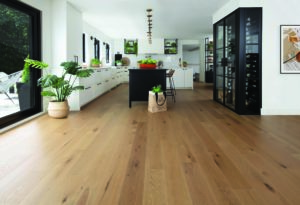
“The largest impact for the hardwood flooring industry has been rising costs on all levels—whether it has been hardwood, glue, plywood, finishes, freight and logistics,” said Brad Williams, vice president of marketing at Boa-Franc, maker of the Mirage brand. “All categories have been increasing in cost—salaries, insurance, etc. Inflation is a real thing that we haven’t experienced in many years at this level. The market seemed to be able to absorb it in 2021 due to renovation and construction growth we had due to COVID-19 and low inventories on the market. We will see if it will sustain for 2022.”
Record inflation is also the No. 1 concern at Harris Wood, primarily a hardwood flooring manufacturer that also sources some resilient products. “The costs are rising for everything, whether it’s the wood itself or the price of the cardboard used to packaging materials, pallets—the whole nine yards,” said Renee Tester, vice president of marketing, e-commerce and digital for QEP, parent company of the Harris Wood brand. “It’s not just the finished goods itself.”
Escalating costs are also keeping suppliers like The Dixie Group—maker of the high-end Fabrica Wood brand—up at night. “Inflation is still that ugly word and that we’re just keeping a constant eye on that,” said Jamann Stepp, vice president of residential hard surfaces. He said the company plans to implement another price increase in mid-April based on higher costs the company is incurring in raw material increases as well as ocean freight. “It’s all continuing to hit us,” he said.
Fabrica Wood is feeling the pinch as the bulk of its finished hardwood flooring products are sourced from different regions around the globe. “Most, if not all, of our hardwood products come from Southeast Asia,” Stepp said. “We’re bringing in material from Vietnam, Indonesia and Malaysia, and container rates out of those countries has been increasing. Meanwhile, the 20-foot container rates on rigid core vinyl products out of China and some other places have actually stayed flat or gone down just a tiny bit. They haven’t gone down drastically, but they’ve gone down a little in some cases.”
Many manufacturing executives describe what’s currently happening as the “perfect storm” of challenges that are impacting category growth. “There are multiple issues having significant impact on the hardwood flooring market—inflation, logistical challenge and raw material availability are some of the biggest,” said John Hammel, senior director, laminate and hardwood business, Mannington. “The instability of the current conflict in Ukraine has increased the volatility in the market.”
How suppliers are responding
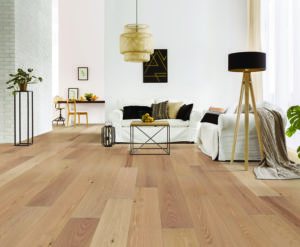
Manufacturers—domestic suppliers and importers alike—are not sitting idly by as inflation, pricing pressures, shipping delays and raw material shortages wreak havoc on profits. In the midst of all these challenges, suppliers are resorting to creative measures to keep the pipeline moving in the face of still-strong consumer demand.
“We continue to cast our net wider for raw material supply and continuously rebalance supply vs demand,” Boen’s Natkin said. “It is certainly getting tougher with the uncertainties on raw material pricing and availability.”
At Indusparquet, which sources entirely out of South America, access to raw materials, rising freight and currency fluctuations have caused some wrinkles. Still, according to Jodie Doyle, vice president of sales and marketing, demand is strong. “Our retail and distribution partners are reaching out and telling us they are seeing increased demand for our products, which is exciting,” he said. “We are doing the best we can to build our raw material and finished good inventory, but it’s honestly a challenge right now. Fortunately, we are also seeing tremendous momentum with our Brazilian oaks in both solid and engineered formats. Our company has been around for 52 years, so we have seen these swings in demand before and we’re in a great position to manage this challenge.”
Mohawk, which outsources the bulk of its hardwood program, is working closely with its vendor partners to ensure a consistent supply—to the extent that it can control that supply while managing costs. “For us it’s really about the discipline and the robust and rigid procedures that we have put into our sourcing process,” Moore explained. “We have a very sophisticated quality assurance program with the vendors that we use. We have boots on the ground in the countries that we source from, inspecting the product as it comes in. We have a very exhaustive vendor onboarding process where we inspect them for multiple things and have people reinspect. And we have good relationships with our vendors. They want to do business with us. We treat them fairly. And so, we’ve got people that want to make us product, No. 1. Plus, we’re checking to make sure that it’s up to the standards that we’ve set.”
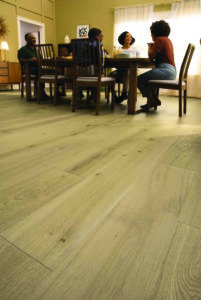
It can’t hurt that Mohawk has the size and scale to mitigate some of those costs. “Certainly, from an import perspective, we have a big business on the hardwood side as well as the resilient side of the business,” Moore said. “We get to leverage our purchasing power when it comes to these shipping companies across all the products and all of the things that we’re moving all over the world. So in terms of being able to secure the equipment, maintaining a low cost or a value on that as compared to a local distributor who’s grabbing 50 containers a year, we’re moving significantly more volume than that. Along with that volume usually comes some price advantages.”
At Mullican Flooring, which sources its hardwood products locally and manufactures in the U.S., the strategy to deal with the aforementioned challenges is all-encompassing. “We are investing more money in automation equipment, spending more on the hiring process by investing in advertising campaigns and increasing wages to attract new hires,” said Neil Poland, president.
For other domestic manufacturers like QEP, parent of the Harris Wood brand, it’s all about keeping open the lines of communication and making adjustments accordingly. “We have communications that go out to our internal teams to notify them if we have any products that could be potentially delayed,” Tester explained. “In turn they can keep customers aware of any potential delays that they can incur. We also let customers know that, ‘Hey, I know you selected this color for your project but we have this color now. Could this be an alternate solution to complete your job?’ Having the flexibility in our product lines to have the ability to find solutions.”
At Shaw, which is also contending with raw material constraints and rising transportation and labor, the key lies in flexibility and adaptability. “We are partnering with our suppliers to prioritize demand, exploring other supply avenues, recruiting for additional carriers beyond our Shaw Fleet—which already offers a competitive advantage—and diligently monitoring market conditions to mitigate rising costs whenever possible,” said Kyle McAllister, director of hardwood and laminate category, Shaw Residential. “As always, we’ll navigate these challenges alongside our customers, and we’ll continue to provide timely and transparent communications as circumstances evolve.”
If nothing else, the supply chain issues the industry is collectively facing have forced all channel members to take a more collaborative approach to finding solutions. “We have longstanding relationships with a lot of vendors we source from,” Tester said. “While the availability has been somewhat limited, we’re still able to maintain an edge as of today.”
Mannington’s Hammel concurred. “We continue to be laser-focused on our internal processes and work closely with our supply partners to manage these challenges,” he explained.
At the end of the day, the most important thing for manufacturers is to have product that retailers and distributors can buy to be able to satisfy their customer needs. “Consistent quality is where our trademark is, but also giving consistent and reliable delivery times as to when their customers can expect to receive their product,” Mirage’s Williams said. “Aligning the supply and installation chain has been a major headache for our customers on many products they source from all over the world. Our goal is to be a supplier that they can rely for product and reliability as to when they will get it.”
Outlook for remainder of 2022
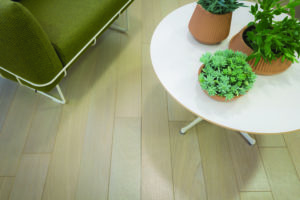
While the issues hardwood suppliers are facing today are significant and ongoing, the general consensus is the segment will still post gains by year’s end. While some are not forecasting sales increases to the extent that we saw in late 2020 and most of 2021, they are expecting positive momentum nonetheless.
“Our business continues to do very well, and we are bullish about 2022,” said Brian Carson, president and CEO, AHF Products, which operates eight production facilities—most of which are located within the U.S. “We have seen a continued strength in hardwood demand, and we expect to continue in the high single digits. Hardwood flooring has rebounded thanks to strong single-family remodel and new home construction activity, which we expect to continue. Signs remain pointed in the right direction, with pent-up demand still vibrant.”
At Wickham Hardwood, which reported its best sales year ever in 2021, the outlook is still positive albeit tempered. “Last year represented a strong year for hardwood flooring,” said Paul Rezuke, vice president, U.S. sales. “Early indications are that the category will continue strong but in all likelihood not at the rate of last year.”
Boa-Franc is also of the mind that 2022 sales will be softer versus last year. “Last year we had a major boom in sales and orders, but a lot of that was also to fill the pipeline,” Williams noted. “We are feeling that the pipelines are full at the moment. Manufacturers, distributors and retailers are all reporting record inventories and installations are not going fast enough. We are in a good position to support the hardwood flooring customer from a service point of view, but our belief is that demand could be a little softer from last year. Better than pre-COVID, but slightly softer from the peak in COVID that we experienced in 2021.”
Somerset, a domestic supplier, is concerned the overall wood flooring pie will shrink given all the issues the industry is facing. “I am concerned that wood will lose market share this year,” Stringer stated. “The cost of lumber is not doing us any favors, and with the inflationary pressures, I think buyers will be more focused on reducing costs somewhere—and flooring is normally at the end of the budget sequence.”
Others, like Mohawk’s Moore, believe low, double-digit sales is still attainable—even in the current environment. “The demand is still very high. I think we’ve positioned our product portfolio exactly where it needs to be. We’re extremely excited about the opportunities that we have to grow our hardwood business in ’22 and ’23.”

